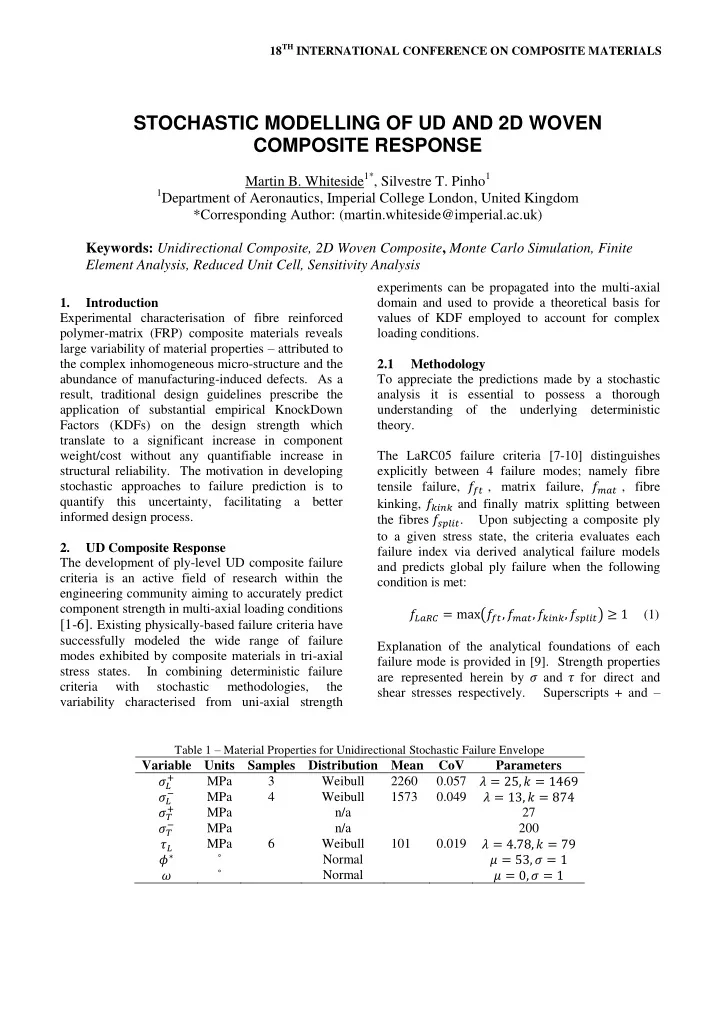

18 TH INTERNATIONAL CONFERENCE ON COMPOSITE MATERIALS STOCHASTIC MODELLING OF UD AND 2D WOVEN COMPOSITE RESPONSE Martin B. Whiteside 1* , Silvestre T. Pinho 1 1 Department of Aeronautics, Imperial College London, United Kingdom *Corresponding Author: (martin.whiteside@imperial.ac.uk) Keywords: Unidirectional Composite, 2D Woven Composite , Monte Carlo Simulation, Finite Element Analysis, Reduced Unit Cell, Sensitivity Analysis experiments can be propagated into the multi-axial 1. Introduction domain and used to provide a theoretical basis for Experimental characterisation of fibre reinforced values of KDF employed to account for complex polymer-matrix (FRP) composite materials reveals loading conditions. large variability of material properties – attributed to the complex inhomogeneous micro-structure and the 2.1 Methodology abundance of manufacturing-induced defects. As a To appreciate the predictions made by a stochastic result, traditional design guidelines prescribe the analysis it is essential to possess a thorough application of substantial empirical KnockDown understanding of the underlying deterministic Factors (KDFs) on the design strength which theory. translate to a significant increase in component weight/cost without any quantifiable increase in The LaRC05 failure criteria [7-10] distinguishes structural reliability. The motivation in developing explicitly between 4 failure modes; namely fibre stochastic approaches to failure prediction is to tensile failure, , matrix failure, , fibre quantify this uncertainty, facilitating a better kinking, and finally matrix splitting between informed design process. the fibres . Upon subjecting a composite ply to a given stress state, the criteria evaluates each 2. UD Composite Response failure index via derived analytical failure models The development of ply-level UD composite failure and predicts global ply failure when the following criteria is an active field of research within the condition is met: engineering community aiming to accurately predict component strength in multi-axial loading conditions (1) [1-6]. Existing physically-based failure criteria have successfully modeled the wide range of failure Explanation of the analytical foundations of each modes exhibited by composite materials in tri-axial failure mode is provided in [9]. Strength properties stress states. In combining deterministic failure are represented herein by and for direct and criteria with stochastic methodologies, the shear stresses respectively. Superscripts + and – variability characterised from uni-axial strength Table 1 – Material Properties for Unidirectional Stochastic Failure Envelope Variable Units Samples Distribution Mean CoV Parameters MPa 3 Weibull 2260 0.057 MPa 4 Weibull 1573 0.049 MPa n/a 27 MPa n/a 200 MPa 6 Weibull 101 0.019 ˚ Normal ˚ Normal
( , ) are assumed Normal, , Eq. (3). In this indicate tension and compression, and subscripts and symbolize the longitudinal and transverse instance the Normal distribution represents a symmetrical distribution about the sample mean directions with respect to the global fibre direction respectively. Additional input variables used include and characterised by the sample variance using the the matrix fracture angle under pure compression, expression: and the global fibre misalignment angle, . (3) 2.1.1 Uncertainty Analysis The stochastic failure envelopes are generated via 2.1.2 Sensitivity Analysis parallelised Monte Carlo simulation of the Consider a deterministic model defined deterministic LaRC05 criteria. The variability of and square integrable in the unit hypercube each stochastic input parameter is modeled by . The function can be defining each a probability density function PDF, conceived to incorporate the mapping of to the and associated cumulative density function, true physical distributions of the input variables via CDF, . The method propagates this uncertainty their respective probability density functions. Sobol through the deterministic LaRC model by repeated defines a main global sensitivity measure as the ratio sampling. For the purpose of modeling the [12]. , , , , ) observed strength characteristics ( distributions, 2-parameter Weibull , are (4) employed, Eq. 2. and are referred to as the main effects of - whom describe the expected reduction of model variance (2) that would be achieved if the value of the parameter was fixed. An additional measure is introduced where parameters and are evaluated through by Homma and Saltelli [13], namely the total effect fitting the function to observed experimental results written as: using the method of Maximum Likelihood Estimation (MLE) [11]. The remaining parameters α = 0.145 Figure 1 : vs. stochastic failure envelope
multidimensional integration, for which Monte (5) Carlo schemes proposed by Saltelli [14] and Jansen where represents a vector containing all [15] are employed respectively. Both UA and SA is variables other than . This measure describes the performed for a finite distribution of stress ratios expected model variance that would remain if all defined by other parameters aside from were fixed. Finally an interaction effect can be defined as [13]: (7) (6) where and are user-defined biaxial plot axes. which provides measure of how much is involved with interactions with any other input variable. The solution of main and total effects requires α α 1.0 1.0 w w T S i 0.5 S i 0.5 σ L - σ L + σ L - σ L + S L S L (a) Main Effect (b) Total Effect α 1.0 Int w S i 0.5 σ L - w σ L + S L S L (c) Interaction Effect Figure 2a. main effect b. total effect and c. interaction effect corresponding to the SFE presented in Figure 1 3
Recommend
More recommend